



THE ERA OF DAM REMOVAL:
River Restoration in the United States
Dam Removal Committee, International Meeting
Nagano, Japan - March 27, 2004
Presentation by Elizabeth Maclin of American Rivers
1: Dam removal in the United States is no longer considered a fringe, radical
approach to restoring rivers-because of this, there are significantly more
opportunities to use dam removal as a river restoration tool, where appropriate,
on dams both large and small; old and new; obsolete and still serving a
purpose. My presentation today will focus on four primary topics: (1) statistics
on U.S. dams and U.S. dam removal; (2) case studies on early U.S. dam removals;
(3) case studies on recent U.S. dam removals; and (4) case studies on future
U.S. dam removals.
2: The United States has constructed many dams on our nation's rivers. The U.S. Army Corps of Engineers has an inventory of the larger structures (those over 6 feet tall with an impoundment greater than 50 acre-feet, or over 25 feet tall with an impoundment greater than 15 acre-feet) that numbers almost 77,000. But the National Research Council estimates that there many be as many as 2.5 million dams in the United States if the smaller structures are also included. However, despite this large number of dams, a very small number actually produce hydropower-only 2,500. The tallest dam in the United States is the 770-foot Oroville Dam in California. The dam with the largest impoundment is the Hoover Dam in Nevada with a reservoir of 30 million acre-feet. And the dam that produces the most hydropower is the Grand Coulee Dam in Washington that has a capacity of 6180 megawatts.
| Embrey Dam Rappahannock River, Virginia |
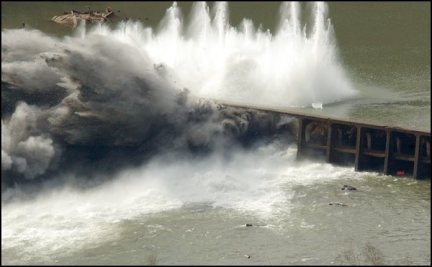 |
3: The United States has a significant number of both large dams and small dams, examples of which are shown here on this slide. Constructing-or removing-a small dam from a small river can have as significant an impact as constructing-or removing-a large dam from a large river. Some may view small dams as insignificant or benign-or may think that removing a small dam is not a noteworthy endeavor. But a small dam that is the centerpiece of a community may be significantly harder to remove than a large dam that does not have surrounding constituents. Or a small dam may still serve a function, where a large dam may have outlived its usefulness. For these reasons, each dam and dam removal needs to be considered on its own merits, and the outcomes associated with the removal should not be pre-determined based on size or the dam's utility.
4: While many of the dams being removed in the United States are old, smaller structures that no longer have a purpose, there are also larger dams being removed and dams being removed that are being used for a variety of reasons including those that still generate a significant profit for their owners. The justification for such removals is that some costs associated with certain dams, particularly their impacts on fish and wildlife populations, cannot be warranted despite the benefits the dams might supply. In my presentation today, I will provide examples of both large and small removals, removals where the dam still served a useful purpose and removals where the dam's usefulness has long since past.
5: Dams all across the United States have been-and are in the process of being-removed for three primary reasons: ecological, safety, and economic. In recent years, removals have been instigated for ecological reasons more often than they have in the past, however this is not to say that early dam removals did not occur for ecological reasons as well, as some of my slides will demonstrate. And while more and more dams are being examined for removal in an effort to restore rivers to a more natural state, most removal decisions, even today, involve a combination of all three reasons.
6: While dam removal only became well recognized as an effective and reasonable river restoration tool within the past five years, dam removal in the United States has been occurring for at least a century and probably longer. The first documented dam removal about which we know is the Marquette Dam that was removed in Michigan in 1912. Approximately 600 dams have been removed to date in the United States with 140 of those occurring in the past five years. While many of the dams that have been removed are smaller structures, this is not always the case. The tallest dam that has been removed in the United States is the Duck Creek Dam in Tennessee, which was 160 feet tall and was removed in 1995. The longest dam removal to date, at least of which American Rivers is aware, is the 1060-foot long Lewiston Dam that was removed in Idaho in 1973.
7: As mentioned a few minutes ago, not all of the dams that have been removed in the United States have been small structures. Shown here is research presented by Dr. Molly Pohl of San Diego State University in 2001 that records the average and the maximum heights of dams removed from the 1920s through the 1990s. And in research done by American Rivers for our 1999 Dam Removal Success Stories report, we found that there are more than 40 dams that have been removed that are 40 feet or taller, including 4 dams that were 120 feet or taller.
8: As I mentioned before, dam removal has been occurring in the United States for at least the past century-and not just for safety and economic reasons, but also for ecological reasons. The next few slides that I am going to present include some examples of dams that were removed in the United States between 1934 and 1989.
One important early dam removal in the United States-which occurred in 1934-was the removal of Sunbeam Dam that was implemented in order to restore salmon runs on the upper Salmon River in Idaho. The Sunbeam Dam was built in 1910 to provide power for a mining endeavor. Although a fish ladder was provided at the dam, it did not work properly and sockeye salmon were immediately eliminated upstream of the dam. The Idaho Department of Fish and Game paid to have the south abutment of the Sunbeam Dam blown out in 1934 in order to help restore the fishery. Twenty years later, the sockeye population on the Salmon River had returned to over 4000 fish. However, by the mid-1950s the dams on the main stem of the Columbia and Snake Rivers were being constructed and upon their completion in 1975, Salmon River sockeye were moving toward extinction.
9: Another early dam removal conducted for ecological reasons was the deconstruction of the Grangeville Dam in 1963-a functioning hydropower dam located in north central Idaho on the South Fork of the Clearwater River. After the dam's fish ladder failed in 1949, the steelhead runs were extirpated on this tributary of the Clearwater River. The dam's owner, Washington Water Power Company, decided to remove the dam, which was 56 feet tall, because the reservoir was filling with silt and because of the dam's negative impacts to migratory fish. After removal of the Grangeville Dam, salmon and steelhead returned to the South Fork of the Clearwater upstream of the former dam site. The picture you see here is the front cover of the Isaac Walton League's magazine from 1963, which featured the removal of the dam.
10: These are additional pictures from the Isaac Walton League's magazine that accompanied the article about the Grangeville Dam removal.
| Williamsburg Station Dam Juniata River, PA | |||
| WITH DAM | IMMEDIATELY AFTER REMOVAL | 2 YEARS AFTER REMOVAL | 3 YEARS AFTER REMOVAL |
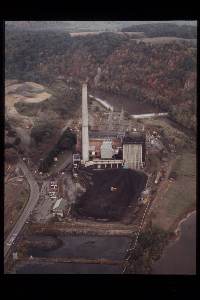 |
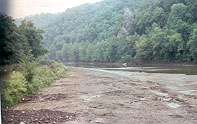 |
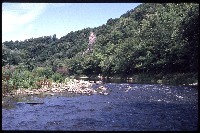 |
|
11: Salmon returns to the Clearwater were lost in 1927 due to the construction of the Lewiston Dam near Lewiston, Idaho at the mouth of the main stem Clearwater River. The dam was still a functional 10 MW hydroelectric facility at the time of its removal in 1973, but WWP agreed to the removal of the project because the reservoir of the newly built Lower Granite Dam on the Lower Snake River would interfere with the operation of the Lewiston Dam. This dam removal opened access to hundreds of miles of the Clearwater and its tributaries and increased the number of salmon and steelhead returning to the Clearwater to spawn.
12: One particularly large dam removal in the United States was the removal of Bluebird Dam, which was built in 1904-and enlarged in 1920-on Ouzel Creek to increase the water storage capacity of a natural lake. The 56-foot tall dam was located in the high alpine wilderness of northern Colorado, in Rocky Mountain National Park. With establishment of the park in 1915, the dam became a safety liability as well as an eyesore in an otherwise pristine wilderness area. In 1982, following the failure of Lawn Lake Dam (also located in the park), the City of Longmont was ordered to repair or breach Bluebird. The removal of Bluebird Dam-which occurred in the summers of 1989 and 1990-eliminated significant safety hazards, made aesthetic improvements in an alpine wilderness, and improved flows for the threatened greenback cutthroat trout.
13: While all of the dam removals that I just discussed were important in their own unique way for the evolution of river restoration in the United States, no single dam removal has had more of an impact on rivers across our country than the removal of the Edwards Dam from the Kennebec River in Maine in 1999. This is because the removal of the Edwards Dam reflected a shift in how U.S. society views rivers. The dam's removal was nationally significant because the federal government ordered the removal of the structure against the wishes of the dam owner. Thus demonstrating that the government finally recognized that a free-flowing, healthy river that is full of fish and wildlife species can be more valuable than the electric power and private profit it produces.
14: While it took over a decade of dedication and enormous effort on the part of river conservation non-profits and state and federal resource agencies, the result-both for the Kennebec River and rivers across the country-has exceed our expectations. On the screen are a handful of the hundreds of media stories that the Edwards Dam removal generated across the country.
15: In addition to all of positive media coverage the Edwards Dam removal generated, the ecological, recreation, and economic benefits of the removal itself have been numerous and diverse. All ten species of migratory fish have been found above the site of the former Edwards Dam site, some species in record numbers; wildlife have made a come-back on the river; water quality has significantly improved; boaters and anglers have returned to the river; numerous rapids have been revealed; the riverbanks are green with native grasses, shrubs, and other vegetation; river-related business are flourishing; and new development is occurring in the city as a direct result of the restored Kennebec River. In fact many of the benefits of dam removal that you see listed here have occurred on the Kennebec River. The next series of slides will feature dam removals that have occurred in recent years, most after the removal of Edwards Dam, further highlighting the benefits that can result when a dam is removed from a river.
16: The Williamsburg Station Dam on the Juniata River in Pennsylvania was an inactive dam that formerly supplied cooling water for a coal-fired power plant. Prior to its removal, the dam contributed to water quality and sedimentation problems in this section of the Juniata River and also prevented the movement of resident fish species. In 1996, the dam's owner decided to remove the dam and the adjacent power plant, which had ceased to operate. When the dam was removed, in addition to opening 20 miles of habitat for fish species, the water quality and sedimentation problems once associate with the site were alleviated and the abundance of fish increased, providing local anglers with additional fishing opportunities. The Williamsburg Station Dam removal was one of the first dams removed in Pennsylvania, a state that now has undertaken over 60 dam removals. After just three years, it was impossible to tell that the dam once existed on this stretch of the Juniata River.
17: The Kissimmee River Dam and the associated boat lock were removed in June 2000 as part of a larger $500 million project to restore the Kissimmee River to its natural state that is being conducted by the U.S. Army Corps of Engineers and the local water management district. While many view the U.S. Army Corps of Engineers as a builder of dams, in recent years, this agency has also become involved in many river restoration projects, including the removal of a number of dams across the country-some of which I will discuss in the next few slides. With the Kissimmee River dam removal, the Army Corps has reconnected and restored 14 miles of natural meandering river channel and has allowed water to overflow on the floodplain, amplifying wetlands. Shortly after completion of this phase of the project in February 2001, the region suffered a record drought that caused little water to flow until June 2001. Since then, continuous flow was re-established and the river has experienced physical, chemical, and biological changes indicative of restoration. The river channel has been flushed of accumulated organic sediments, the dissolved oxygen level that was once a critical limiting factor has increased, changes have occurred in the invertebrate food base, and use of the river channel by shorebirds has risen. Another dam is going to be removed within the next few years as part of the second phase of this project.
18: The Billington Street Dam was removed from Town Brook in Massachusetts in 2002. Erosion at this over 200-year old earthen dam and deterioration of its fishway had blocked migration of alewives each spring. Removal of this dam and restoration of Town Brook is restoring the fishery in an area where the pilgrims historically came to fish for alewife. The removal is expected to increase river herring and alewife populations ten-fold, to more than 100,000 fish each year. The project cost $350,000 and had numerous partners including the federal, state, and local government as well as non-profit organizations. The removal of Billington Street Dam was also the first removal of a coastal dam in the state of Massachusetts.
19: A 1996 flood on the Presumpscot River in Maine extensively damaged the Smelt Hill Dam preventing the facility from producing power without first undergoing expensive repairs. Instead the owners decided to remove the dam-which was a stone-filled, timber-crib structure 151 feet long, 31 feet wide and 15 feet tall-opening this stretch of the river for migratory fish for the first time in over two centuries. The state of Maine and a local conservation group spearheaded the removal of the dam-which occurred in 2002-with significant funding and engineering provided by the U.S. Army Corp of Engineers, who was the primary agency responsible for the removal. Dam removal is expected to restore the lower portion of the Presumpscot, creating habitat for striped bass, smelt, river herring, and American eel and opening passage for other migratory fish. Already American shad and alewife have been documented seven miles upstream at the base of the next dam. Efforts by a local river group and American Rivers are currently underway to remove four additional dams on the river, three of which are operating hydropower dams.
| Kissimmee Lock & Dam Kissimmee River, Florida |
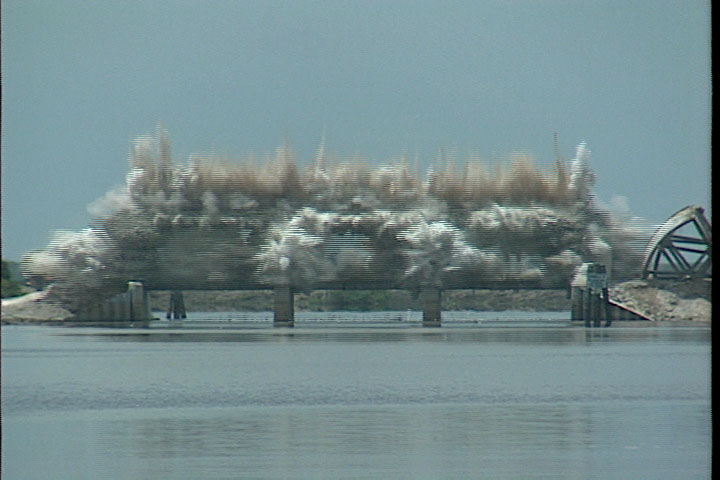 |
20: February 23, 2004 was another landmark day for rivers in the United States as the U.S. Army Corps of Engineers detonated 600 tons of explosives to breach the Embrey Dam on the Rappahannock River in Virginia. Approximately 5,000 people from the surrounding area gathered on the banks of the river to celebrate the liberation of the Rappahannock and the benefits it will bring to the surrounding community. The initial breaching of this structure is part of a longer-term removal process that will clear the entire dam out of the river by 2006. With the removal, more than 170 miles of habitat are now open to several species of migratory fish, including American shad and river herring, and will soon be open to recreationalists and other river lovers. This removal is notable for a few primary reasons: (1) the Army Corps of Engineers is the agency responsible for removing the dam; (2) the removal was fully funded by the U.S. government because of a powerfully ally in the U.S. Senate-Senator John Warner a republican from Virginia who wanted the dam removed in order to restore fish populations and angling opportunities; (3) it is one of the largest removals to date on the East Coast of the United States, both in terms of the size of the dam and the amount of habitat that will be restored.
21: While the majority of removals that have occurred in recent years have been smaller structures, these removals have nonetheless had a big impact on rivers in the United States bringing countless fishing and recreational opportunities, as well as additional benefits to communities across the country. This does not mean, however, that removals of larger dams in the United States are not being proposed or implemented. That fewer larger dams have been removed in recent years, may be more of a reflection of the significant amount of time it takes, both to engineer and design larger dam removals and to raise the necessary funds to complete larger removals. The next few slides will show examples of some of the large dams that will be removed in the United States over the next five years.
22: Before Condit Dam was built in 1913, the White Salmon River was populated by abundant runs of salmon and steelhead that produced enough food resources to support two Native American villages. Only one other dam blocks fish passage between Condit Dam and the Pacific Ocean. In 1993, the dam owner's (a private hydropower company) operating license to generate hydropower at Condit Dam expired and the federal agency that regulates non-federal hydropower dams was forced to decide whether and under what conditions to issue a new license for the dam. The federal government initially advocated installing fish passage at a cost of $30 million rather than breaching the dam, but the dam owner concluded that dam removal was a less expensive alternative than building fish passage and proposed to breach Condit Dam at an expected cost of $17.15 million. The power company is paying the full cost of the removal. The state biologists estimate that removal of Condit Dam could reestablish runs of about 700 steelhead adults, 4,000 spring chinook adults, 1,100 fall chinook, and 2,000 coho salmon. The removal is anticipated to occur in 2006, assuming that all regulatory permits can be obtained by that time.
23: Glines Canyon Dam and Elwha Dam virtually wiped out the once abundant salmon and steelhead populations of the Elwha River, fisheries to which the Elwha Klallam Tribe had been guaranteed rights in perpetuity through a treaty agreement in 1855. Prior to the construction of the two dams, the Elwha River was the backbone of a self-sustainable and thriving ecosystem-the salmon from which the Klallam Tribe had lived and depended for over a millennium. However, when the dams were built in the early 1900s they cut off over 71 miles of anadromous fish runs, leaving only 4.9 miles of natural spawning grounds for salmon and trout.
24: In the 1970s when the Glines Canyon Dam license to produce hydropower came up for renewal, environmentalists and tribal representatives began trying to remove these two dams. One of the dams, Glines Canyon Dam, is located in Olympic National Park, a World Heritage Site, and both of the dams impact the Park. In 1992, a special act of the U.S. Congress approved purchasing the dams from the dam owner and directed a federal agency to study how the river and native fisheries could be completely restored. Their recommendation was that only removing the dams could fully restore the ecosystem.
Federal appropriations for dam removal are being actively pursued. In fiscal year 2000, the U.S. Congress finally appropriated enough money for the National Park Service to purchase the two dams-and in February 2000, the National Park Service purchased the dams from the dam owner for $29.5 million. Enough money has also been appropriated to the National Park Service to complete the engineering and design phase, as well as the first deconstruction phase of the project. However, Congress must still appropriate funds (approximately $50 million) for the actual removal of the two dams, as well as for the associated river restoration. The estimated removal date, if the funding is provided in a timely manner, is 2007.
25: The following pictures show an illustration of how the restored river might look at the site of the Glines Canyon Dam.
26: The Matilija Dam is located within the Los Padres National Forest near the headwaters of the Ventura River in southern California. The dam, which is owned by the county of Ventura, was built in 1947 as part of the Ventura River flood control system and to provide water for the Ojai Valley. Due to a lack of fish passage at Matilija Dam, endangered steelhead are blocked from approximately 85% of their existing habitat in the Ventura River. Removal of the dam (as well as installing fish passage at the Robles Diversion Dam located downstream) would open 30 miles of habitat to the endangered fish. Due to severe silt build-up behind the dam, Matilija Dam no longer provides flood control benefits and provides only minimal water storage capacity. The reservoir, which originally held 7,000 acre-feet of water, now holds only 500 acre-feet-and the storage capacity continues to decrease each year. While nearly everyone agrees that this dam should be removed, the massive amount of sediment in its reservoir makes the removal particularly difficult and expensive to engineer. The U.S. Army Corps of Engineers is currently conducting a feasibility analysis to determine the best method to remove the dam and restore the river. The estimated removal date, assuming that funding is obtained for the project is in 2007 or 2008.
27: In October 2003, the federal government, state of Maine, a power company, the Penobscot Indian Nation and four conservation groups, including American Rivers, announced a historic deal to restore the Penobscot River in Maine by purchasing three operating hydropower dams, removing two of them, and building a nature-like bypass channel around the third. The Penobscot River Restoration Project is one of the most progressive and comprehensive attempts in U.S. history, representing the single most important action to recover endangered wild Atlantic salmon in the United States. This unprecedented approach to river restoration will reconfigure hydropower facilities and maintain energy while opening up more than 500 miles of habitat to 10 native species of sea-run fish, improve water quality, boost wildlife and create new opportunities in communities along New England's second largest river. The project is expected to cost approximately $50 million and will result in the removal of the dams sometime between 2006 and 2010.
28: This map shows the current habitat that is blocked by the dams on the Penobscot. And this next map shows the amount of habitat that will be opened when the restoration project is complete-over 500 miles. This represents 100% of historic habitat for five species of fish and over half of the historic habitat for the other affected species, including Atlantic salmon.
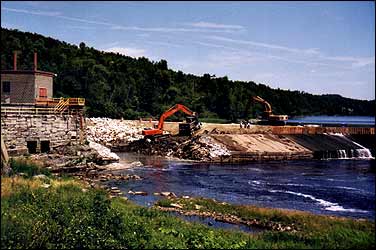
29: In 1999, American Rivers initiated our campaign, Rivers Unplugged. We have two goals for our campaign; the first and foremost is to restore rivers by removing dams that don't make sense. And second is to help expand the national interest in using dam removal as a river restoration tool. In order to accomplish these two goals, we use the 4 primary strategies: (1) provide technical assistance and other guidance to dam removal efforts; (2) eliminate obstacles to dam removal; (3) develop and distribute resources materials; and (4) broadly promote benefits of dam removal Since our campaign started five years ago, we have seen over 140 dams removed from our nation's rivers-largely due to the efforts of local river conservation organizations, state and federal natural resource agencies, and community groups that do the tough on-the-ground work necessary to make our rivers healthier.
30: One aspect of our campaign that might be particularly helpful to those working on dam removal in Japan, are the dam removal resource materials that American Rivers and our partners, particularly the River Alliance of Wisconsin, have produced over the past five years. The dam removal resource materials provide detailed information on the various aspect of dam removal, including: dam removal success stories; a decision-making guide to help in dam removal efforts; information on ecological benefits and impacts of removal; reports that make federal and state policy recommendations related to dam removal; information on the economic benefits and impacts of dam removal; a report on how to pay for dam removal; and many, many more. While these resource materials are all written for an audience based in the United States, there may be information in some of the publications that will help in the effort here in Japan to restore rivers by removing dams that no longer make sense.
31: Contact Information - Elizabeth Maclin; Director, Rivers Unplugged
campaign; American Rivers; 1025 Vermont Avenue, NW - Suite 720; Washington,
D.C. 20005; www.AmericanRivers.org